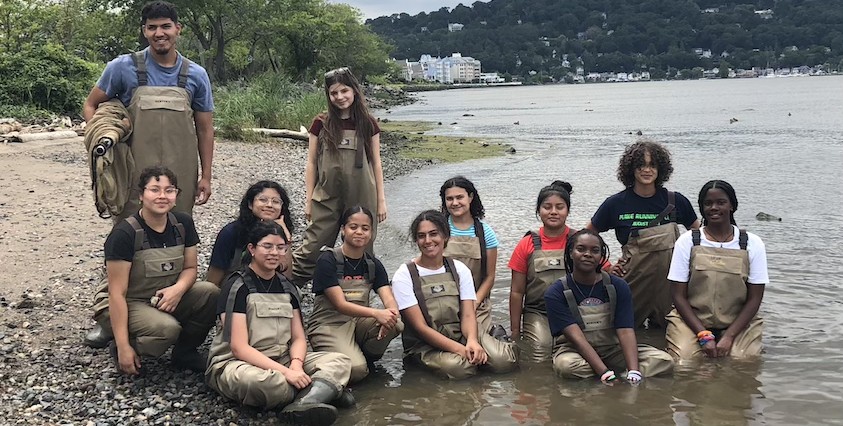Next Generation of Hudson River Educators 2023: Building a Pathway
Our summer 2023 Next Generation of Hudson River Educators High School Internship Program focused on communicating science in diverse ways: community education through Science Saturday support, youth education through focused programs for groups, and peers and school groups through science research posters. Each step required a different type of learning and communicating as the students ‘built a pathway’ into STEM. Our summer cohort included twelve passionate high school students, from throughout the Rockland County area and neighboring New Jersey. Each traveled to the Hudson Field Station, to learn, engage with, and explore the Hudson River Estuary. The group started with a range of preliminary knowledge about the Hudson, and together they grew into educators and researchers through a combination of fieldwork, science communication, and community outreach opportunities over the course of the program.
Over the summer the Next Gen interns gained valuable communication and research skills through hands-on experiences such as hosting over six field trip visits to the field station for students of different ages, and executing data collection that both expanded the Field Station’s databases, and their own understanding of the Hudson. Through their data collection, they learned about the biodiversity of the Hudson estuary while exploring the physical and chemical water properties of the Hudson and its effects on the presence & abundance of species. Each intern bolstered their science communication skills and grew comfortable confidently relaying their knowledge to others as Hudson River stewards and advocates.
A Summer of Collaborations
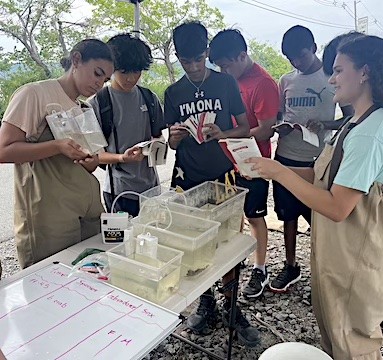
Hudson River Education Field Trips Hosted by Next-Gen
Next Gen interns hosted field trips at the Hudson River Field Station for various groups including Smarter Summer Camp, Dominican College’s High School Summer Program, City Tech College Summer Program and the Haverstraw Center. The Next Gen interns ran various stations and activities to teach participants about estuaries, how to identify fish using a dichotomous key, how to seine, how to conduct water chemistry measurements, and what makes the Hudson River Estuary special and worth conserving. By teaching others the interns cemented their Hudson River knowledge allowing space for more intellectual curiosities and growth.
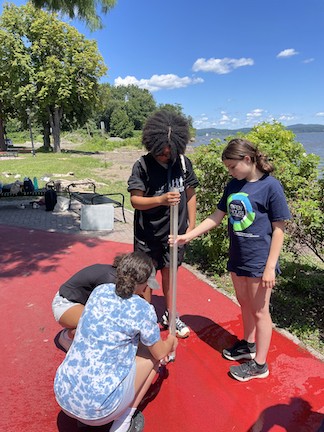
Haverstraw Day; A Day in Emeline Park!
Later in the summer, the interns traveled to Emeline Park in Haverstraw to lead their peers from the Haverstraw Center in seining in Haverstraw Bay, measuring turbidity, and conducting water chemistry tests. Throughout the day the Next Gen interns looked to see if there were any differences or similarities between chemical properties, fish species and turbidity found in Piermont and Haverstraw. The fish species caught were similar, although the salinity was slightly lower in Haverstraw than Piermont. They found that the turbidity in Piermont was higher than in Haverstraw. This could be explained by the difference in precipitation input prior to the sampling, but perhaps more likely it was because Piermont Pier is located closer to the “turbidity maximum” in the Hudson estuary, that place where the salt water and fresh have the most vigorous exchange driving up turbidity. Both the Haverstraw students and Next Gen interns engaged with fieldwork in new terrain and learned alongside each other. They even participated in a scavenger hunt in Emeline Park to look for and identify invasive and native species present in the park.
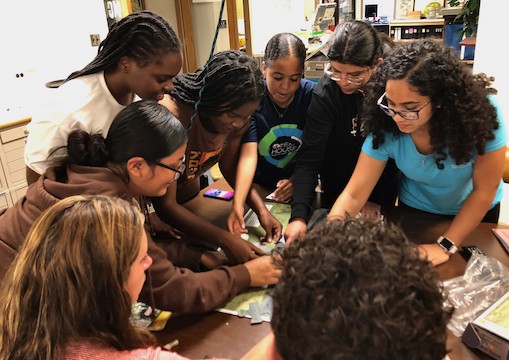
Learning from the Polar Ambassadors Program
The Next Gen interns took a trip to Lamont-Doherty Earth Observatory to meet students in the Polar Climate Ambassadors Program composed of high school students learning and creating educational resources focused on the polar regions, the Arctic & Antarctic, and climate change. The Polar Climate Ambassadors shared with the Next Gen interns what they had learned about the polar regions throughout their time in the program. Next Gen interns learned that many of their previous assumptions about the polar regions were incorrect due to polar representations in pop culture or social media. Additionally, the Polar Climate Ambassadors taught the Next-Gen interns about the difference between ice sheets and sea ice, the different impacts that melting of ice in the polar regions will have on polar ecosystems, sea level rise, and climate worldwide. Next-Gen Interns engaged in activities to visualize Arctic sea ice melt over the past few decades and how this drastic decline in marine ice will impact Arctic ecosystems. Finally, the Polar Climate Ambassadors shared some of their independent video projects built from interviewing scientists who are working on various research projects focused on the polar regions. The films covered an introduction to their work, thoughts on their field experiences, their academic and research trajectories and more.
A Summer For Data Collection, Entry , and Analysis
The Next Gen interns became particularly skilled at collecting and compiling data throughout the summer. They seined and collected fish species and abundance data, at least twice a week, consistently conducted water chemistry measurements, and analyzed patterns across years of data collected at the Hudson River Field Station. They assisted in microplastic & plankton sampling as well as helped to monitor our eastern oyster cages, all fairly new research initiatives at the field station.

Chemical and Physical Water Measurement Parameters and Data Entry
The Next Gen interns consistently measured and analyzed the chemical water properties of the Hudson such as dissolved oxygen, salinity, pH, alkalinity, nitrates, phosphates, and temperature throughout the six-week program. Interns were taught the importance of chemical balance in the Hudson and the effects that imbalanced nutrients or chemical properties can have on the ecosystem. However, they were also introduced to the dynamic nature of the estuary and how it changes with changes in tides, currents, rain and more. Students grew comfortable measuring tides, currents, and turbidity and used those data points to make hypotheses about their tie to chemical water properties and species abundance.
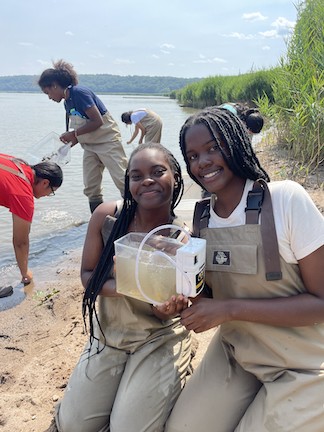
Before seining, each Next Gen Intern learned about the external anatomy of a fish and how differences in their morphology, i.e., mouths or body shape and the number and shape of fins, can indicate a species behavior and lifestyle. The interns used Clearwater’s Key to Common Hudson River Fishes, a dichotomous key, to identify the different species of fish they caught while seining. The Next Gen Interns learned to identify fish species such as the Atlantic Silverside, Atlantic Menhaden, and White Perch by pinpointing characteristics and features unique to each species.
Over the course of the program, the Next Gen interns grew confident packing fieldwork materials and developed the teamwork skills necessary to successfully collect and log fish species and abundance data fairly independently. The interns grew more and more excited about seining throughout the summer finding species of fish they hadn’t caught before. The salinity levels within the brackish waters of Piermont were everchanging and allowed us to observe a range of species throughout the summer. The Next Gen interns even pulled in species that are not common catches in Piermont including hogchokers, Channel catfish, and Atlantic needlefish.
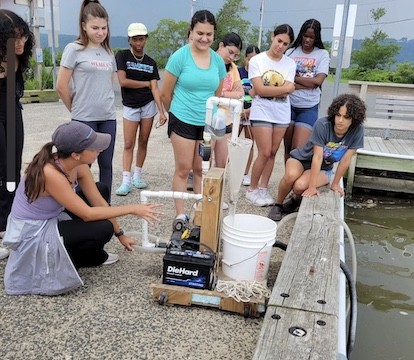
Phytoplankton and Zooplankton Sampling
The Next Gen Interns explored the microscopic world of the Hudson estuary by analyzing water samples collected from the Hudson to look for species of zooplankton and phytoplankton, both of which are vital for providing nutrients and food for small fish and crustaceans and throughout the broader food web. They observed water samples under a microscope numerous times throughout the program to help us understand the seasonality and abundance of plankton in the brackish zone of the Hudson estuary and how salinity, precipitation and tides impact the presence of plankton in the area. With no recent comprehensive research done on plankton populations in the brackish zone of the Hudson estuary, this sampling is vital in expanding our understanding of plankton in this important and dynamic section of the Hudson.
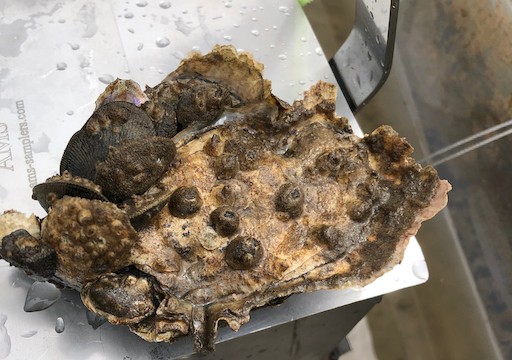
Billion Oyster Project: Oyster Monitoring
The Hudson River Field station has continued its work with the Billion Oyster Project (BOP) as their most northern site and has cages full of Eastern Oysters at the end of the pier. Interns learned about the history of Eastern Oysters in the Hudson, their importance to indigenous communities as a food source, and their importance to the Hudson ecosystem. Additionally, they discovered the mission of the BOP to re-introduce Eastern Oysters as necessary filter feeders and CO₂ fixers in the Hudson.
The cages along the pier were monitored monthly and data was sent to the BOP. The interns worked together to measure the size of live oysters and the abundance of dead oysters to observe their survivability and growth rates. Factors such as salinity and temperature can heavily affect the survival of an oyster due to its preference for colder marine waters. Oysters are ecosystem engineers and provide habitat for smaller fish and crustaceans. An abundance of crab, fish, and shrimp species that relied on the oysters for habitat or food were found in our oyster cages.
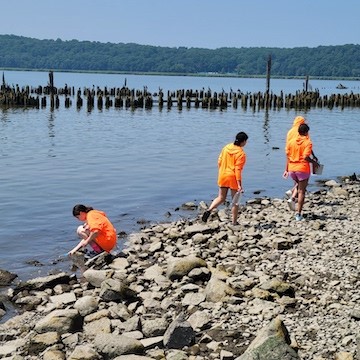
Microplastic Sampling
Prior to sampling along Piermont Pier for the presence of microplastics in the Hudson, the interns learned about microplastics and how they affect aquatic and terrestrial ecosystems. They read scientific articles about the effects of microplastics on avian survival and reproductive ability, and discussed how biomagnification and bioaccumulation increases levels of microplastics throughout a food web.
Interns worked together to sample the Hudson along Piermont Pier to measure the abundance and type of microplastic pollution found in the Hudson. Each group, after collecting their samples, observed them under a microscope lit with ultraviolet light to illuminate the plastic particles. Each shape and color of microplastics found in their samples were logged and entered into a database.Some students proposed preliminary hypotheses that could explain patterns across group results as a product of the area of their sampling sites. They identified 3 sampling areas of interest to target and understand inputs of microplastic pollution into the Hudson along Piermont Pier.
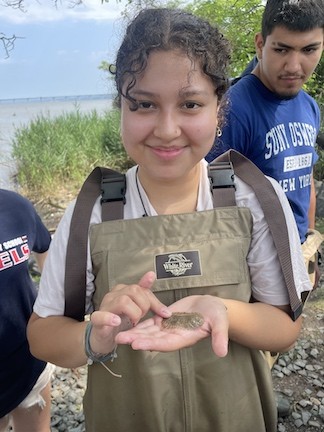
Creation of Scientific Posters
The last week of the program the interns were given the task of creating their own scientific posters to present on the data they collected over the summer and comparing it to past years data. Some interns chose to examine chemical parameters,and precipitation data to look at connections across these parameters. Other interns chose to focus on fish species abundances over the years and attempted to observe patterns across seasons, temperature levels, salinity measurements and precipitation levels. After spending 5 weeks collecting data across various parameters the interns were able to make hypotheses about their data and propose where future research should be done. A group of Next Gen Interns went to a local science symposium to present their scientific poster to their community and peers.
Exploring Freshwater Species and Ecosystems
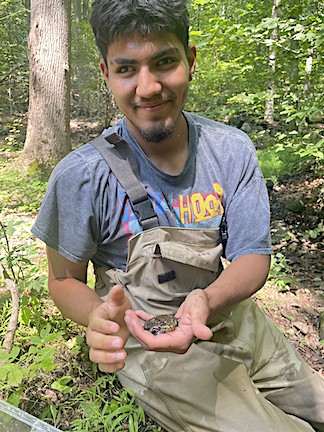
In the last week of the Next Gen Program the interns traveled to Tackamack Park to explore and learn about freshwater ecosystems, after spending the majority of the summer focused on brackish water ecosystems. The students spent much of their time enjoying the abundance of frogs found throughout the streams, even catching frogs in the process of transitioning from their juvenile tadpole stage to their adult stage. Amongst the many amphibians found in the streams, the Next Gen Interns got a chance to recognize some freshwater fish and crayfish hanging out in the stream.
Conclusion
Next Gen interns formed passions for marine biology, geology, environmental conservation, youth activism, and recognized their connections to the Hudson River, as inhabitants of the Hudson River watershed. Each student embraced their love for science by spending hours with the Hudson River ecosystem and growing comfortable with its unique properties and behaviors. They will carry the knowledge they learned from the program with them into their communities and schools to foster their communities' appreciation for the unique and dynamic Hudson River Estuary. The interns continue to stay connected through group activities and show up to help us at our Open House and other community events!

